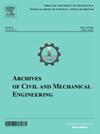Early-age mesoscale deformation in lightweight aggregate concrete under different water-to-cement ratios and pretreated methods
Abstract
This paper primarily investigates the deformation behavior of lightweight aggregate concrete (LWAC) with lightweight expanded clay aggregate (LECA) at early ages. Comparative experiments were conducted on specimens prepared with pre-wetted and dry aggregates and with different water-to-cement ratios. The digital image correlation (DIC) technique was used to measure deformation and calculate the principal strains on the surface of specimens. The variation of global strains and local strains in mortar and aggregates at early ages were analyzed. The results showed that pre-wetted lightweight aggregates can enhance the effect of internal curing, thereby reducing the early-age shrinkage of concrete, and weakening the discreteness of strain distribution in concrete, thus theoretically reducing the risk of cracking. The minimum principal strains of mortar and aggregates did not exhibit a simultaneous increase and decrease trend, but rather interacted with each other, and reached a dynamic equilibrium with moisture transfer between them. The maximum principal strains of aggregate were significantly greater than those of mortar. The effectiveness of internal curing does not increase linearly with an increase in the water-to-cement ratio, but first increases and then decreases, with the optimal internal curing effect achieved around a water-to-cement ratio of 0.40 at early ages.

 求助内容:
求助内容: 应助结果提醒方式:
应助结果提醒方式:


